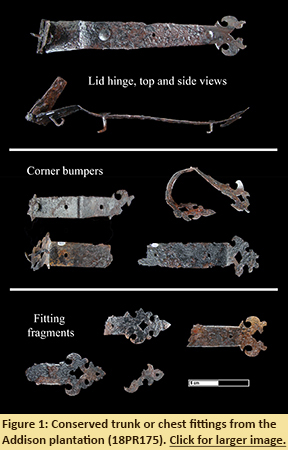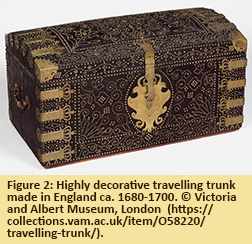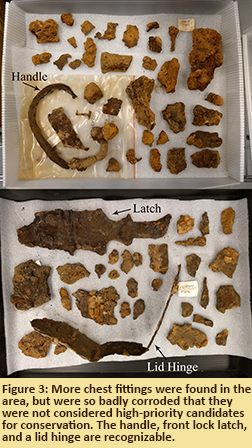Curator's Choice 2018
Stumbling Upon a Storage Chest
March 2018
By Sara Rivers Cofield, MAC Lab Federal Curator
 Archaeologists document everything they excavate because context can tell the story of how the artifacts were used. This Curator’s Choice is a perfect example of why that practice is so important.
Archaeologists document everything they excavate because context can tell the story of how the artifacts were used. This Curator’s Choice is a perfect example of why that practice is so important.
I was recently asked to identify artifacts that might have been used by women in the 18th century. As I looked in our study cabinets, one of the things I wanted to find was evidence of keys and storage chests, since women tasked with running a household would have used these items to control access to valuable things like linens and other domestic provisions. The best examples I found came from the Oxon Hill Manor site (18PR175), a plantation owned by the Addison family in Prince George’s County, Maryland.
 In a drawer full of hinges, door locks, and other architectural items from a structure that was built ca. 1690 and destroyed in a fire by ca. 1730, I discovered what I believed to be decorative trunk or chest hardware (Figure 1). I confirmed this ID by comparing the hardware to surviving examples in museums (Figure 2), and then I looked deeper into the collection in case there were more pieces that had not yet been pulled for conservation and study. Sure enough, a lot of the badly corroded iron found in the same area turned out to represent more chest fittings (Figure 3).
In a drawer full of hinges, door locks, and other architectural items from a structure that was built ca. 1690 and destroyed in a fire by ca. 1730, I discovered what I believed to be decorative trunk or chest hardware (Figure 1). I confirmed this ID by comparing the hardware to surviving examples in museums (Figure 2), and then I looked deeper into the collection in case there were more pieces that had not yet been pulled for conservation and study. Sure enough, a lot of the badly corroded iron found in the same area turned out to represent more chest fittings (Figure 3).
 It is incredibly satisfying to be able to make sense of horribly corroded iron that seems unrecognizable. In the case of this trunk, some pieces are so badly corroded that even when x-rays were taken to look through the corrosion to the object inside, it was still hard to recognize pieces like the front lock plate (Figure 4). It is only possible to figure out what some of the fittings are because of their association with the trunk hardware that is in good shape, which is why it is so important for archaeologists to know which artifacts are found together.
It is incredibly satisfying to be able to make sense of horribly corroded iron that seems unrecognizable. In the case of this trunk, some pieces are so badly corroded that even when x-rays were taken to look through the corrosion to the object inside, it was still hard to recognize pieces like the front lock plate (Figure 4). It is only possible to figure out what some of the fittings are because of their association with the trunk hardware that is in good shape, which is why it is so important for archaeologists to know which artifacts are found together.
Now that the hardware has been identified as parts of a larger piece of furniture, it is possible to get an idea of what the trunk would have looked like. The hinges for the lid have a deliberate bend indicating that the lid was about 2.5” high. Similarly, the bent nails used to attach the iron fixtures can be measured to determine the thickness of the boards used to make the chest. The handle is relatively large, suggesting that the chest was both sizable and heavy-duty. When compared to examples in museums, these components allow for a conjectural recreation. But museum pieces tend to represent the best, most decorative survivals, so it is also important to look at what isn’t present in the archaeological assemblage. This chest was not decorated like the one pictured in Figure 2 because no brass tacks were found nearby.
 In order to understand how the Addisons used this robust iron-bound chest, one need only look at where it was recovered and what other artifacts were found in the same area. This particular group of artifacts was found up against a wall in a wood-lined cellar (Figure 5). The only other artifacts found in quantity there were fragments of wine bottles, signifying that the chest was probably used to store imported wine. This makes sense for the Oxon Hill plantation, because the Addisons were wealthy merchants and tobacco planters who could afford bottled wine, and they might have imported it themselves.
In order to understand how the Addisons used this robust iron-bound chest, one need only look at where it was recovered and what other artifacts were found in the same area. This particular group of artifacts was found up against a wall in a wood-lined cellar (Figure 5). The only other artifacts found in quantity there were fragments of wine bottles, signifying that the chest was probably used to store imported wine. This makes sense for the Oxon Hill plantation, because the Addisons were wealthy merchants and tobacco planters who could afford bottled wine, and they might have imported it themselves.
Shipping records contemporary to the occupation of Addison plantation are indicative of how wine was packaged and valued. In 1697, five dozen bottles of red port and a dozen bottles of canary were packaged in a chest valued at 10 shillings and shipped to Maryland aboard the John. The value of the wine itself (£5.14.0) was listed separately from that of the six dozen bottles that held it (£1.1.0). Another chest arrived in Maryland aboard the Jeffries a year later holding 26 gallons of claret and three gallons of canary in 131 bottles. All components of this shipment were individually valued: the chest (12 shillings), claret (£7.16.0), canary (£1.4.0), bottles (£1.7.6), and corks and wiring (4 shillings) (Sheffield vs. Stark, UK National Archives).
The trunk hardware in the Addison cellar might represent this kind of shipment. The chest itself has iron hardware and a lock for security, and while the ironwork is decorative, it is not as valuable as that of chests with brass fittings and tacks for decoration. A chest used for shipping would transition well to the cellar for storage, where the wine could age in its bottles until the Addisons decided to break it out for dinner, a special occasion, or to entertain guests.
